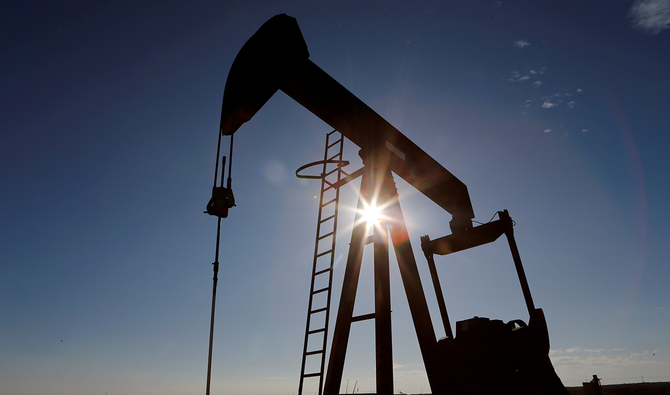
- ARAB NEWS
- 12 Jul 2025

The price of Brent Crude more than doubled since mid-April, but is still down just shy of 50 percent from its January highs. Oil rallied six of the last seven weeks. West Texas Intermediate (WTI) pierced the $42 per barrel mark late Friday. On Monday morning in European trading, Brent stood at $42.34 per barrel and WTI at $39.75 per barrel.
While this is positive, we should not get ahead of ourselves. According to Bloomberg and the International Energy Agency (IEA), global stockpiles of crude and products are nearing 3 billion barrels. Bloomberg’s Julian Lee calculated that, if all of this stored oil were converted to diesel, it would enable every large freight truck in the US to travel around the globe five times.
It is true that the oil price has recently gone into “backwardation” (meaning that a barrel today is more expensive than a barrel in the future), generally a sign of a bull market. The situation, though, is far from certain going forward. A lot will depend on producers, but the big unknown is consumption.
OPEC+, a group of the 13 Organization of the Petroleum Exporting Countries (OPEC) and their 10 non-OPEC allies lead by Russia, had taken 9.7 million barrels per day (bpd) off the market by May and extended the amount through July, with a downward sloping schedule of cuts until the end of April 2021.
The IEA reported that global oil supply had plunged by 11.8 million bpd in May, taking into account the OPEC+ cuts and economic shut-ins in North America and elsewhere.
Compliance was an issue for OPEC+ during the month of May, with Iraq, Kazakhstan and Nigeria the largest shirkers. It was this that led oil markets to fall ahead of last Thursday’s Joint Ministerial Monitoring Committee — the body tasked with ensuring compliance within OPEC+. It is chaired by Saudi Energy Minister Prince Abdul Aziz bin Salman, and Russia’s Alexander Novak. Since then, Iraq has come up with a schedule to compensate for their shortfall in cuts during the third quarter, as has Kazakhstan. Nigeria and Angola were given until June 22 to commit to their compensation schedules.
The decisive action of OPEC+ helped markets start the long road to rebalancing. OPEC’s average production for May stood at 24.19 million bpd, representing the biggest fall of its crude production since 1974.
Developments elsewhere are also significant: The shale space in North America is suffering from low oil prices, as it has relatively high production costs. Shale companies are traditionally highly leveraged, and find debt servicing challenging at current oil prices. To make matters worse, shale production depends on access to capital and liquidity, because of the rapid decline rate of its wells, necessitating constant drilling for new ones. The sector may be forced to write down as much as $300 billion worth of assets during the second quarter, following $38 billion during the first quarter. Bankruptcies will be inevitable. In a market where everybody is strapped for cash, very few companies are left as natural buyers of shale producers with financial problems.
So much for the supply side of the equation. Demand looks better than expected; the IEA forecasts demand to fall by 8.1 million bpd for the year of 2020 and to rebound by 5.7 million bpd in 2021 — still leaving a shortfall of 2.4 million bpd compared to 2019 levels. This is the second upgrade for the agency’s 2020 demand forecasts in as many months, on account of Chinese and Indian demand recovery exceeding expectations. OPEC was more pessimistic in its monthly oil market report, by holding firm on its forecast demand decline of 9.1 million bpd.
In reality, demand is the wildcard and visibility through to the end of the year is hard — let alone for 2021.
While the overall demand picture may look better than expected, indicating a V shaped recovery, that may not necessarily be so when drilling further down. Gasoline rebounded quickly as people used their cars as soon as lockdown restrictions came to an end. However, diesel rebounded much more sluggishly. It is an excellent benchmark for economic activity, because it powers industry and freight. When we take kerosene into account, things look even worse. According to the IEA, jet fuel demand is expected to contract by 3 million bpd in 2020 and only rebound by 1 million bpd in 2021.
These numbers indicate that while OPEC+ does its job in terms of taking excess supply off the market, demand will eventually play a major role in balancing the markets. It is hard to predict demand going forward, due to differing government responses to the pandemic, depending on the shape and trajectory of any recovery. Recent developments in the US and others, which recently loosened lockdown restrictions, suggest a second wave of the coronavirus may happen.
Some analysts forecast that oil markets will become tight, with demand outstripping supply during the second half of 2020. This should not worry us due to the huge inventories overhang. Julian Lee’s calculation about US freight trucks shows that there is, quite literally, a lot of mileage pent up in the system.
• Cornelia Meyer is a business consultant, macro-economist, and energy expert. Twitter: @MeyerResources